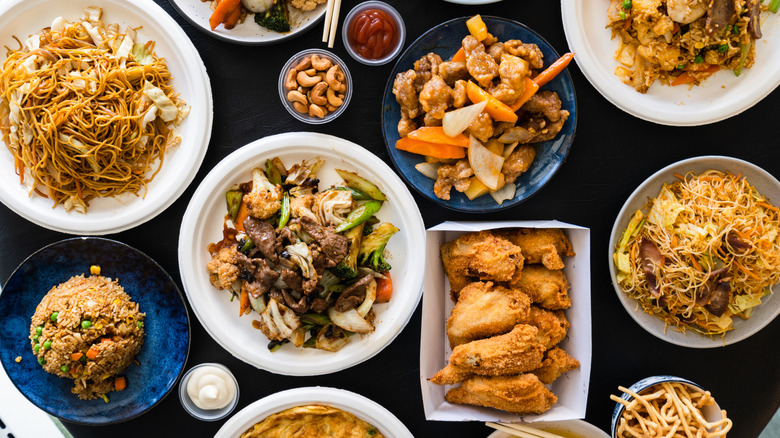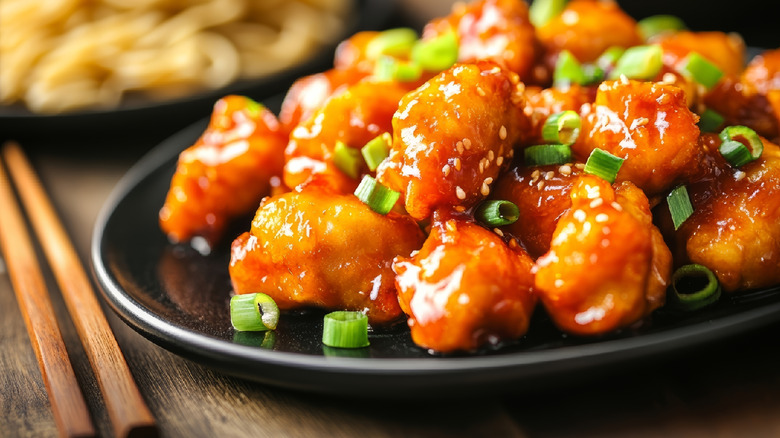The Popular Chicken Dish You Should Pass On At A Chinese Restaurant
One ordering mistake you might make at a Chinese restaurant is not sharing your food with the other guests in your party. (How else can you taste more than one entree?) But another one involves ordering the wrong items. According to Maricel Gentile, owner of Maricel's Kitchen and author of "Maricel's Simply Asian Cookbook," one thing you should definitely skip is sweet-and-sour chicken. "Cantonese sweet-and-sour is an authentic dish, but what we often see in the United States is a magnified version of just one part of the flavor profile," she explained. "Cantonese cooking is about harmony, not excess."
Sweet-and-sour dishes do exist in traditional Chinese cooking, although they're usually made with pork or fish instead of chicken. Gentile described them as being more vinegary, less sugary, and lighter than the version we're used to in the States. "Sweet-and-sour became one of the bridge dishes that introduced Americans to Chinese flavors. Cantonese immigrants adapted their food to fit what local diners expected: sweeter flavors, fried foods, and colorful presentation," she said.
Gentile advised making your own sweet-and-sour chicken since, as she said, "When you cook it yourself, the dish becomes not only tastier, but also more nourishing." (Aldi chicken tenders are perfect for sweet-and-sour chicken, as a quick and easy shortcut.) The recipe, however, needs to combine sweet, sour, and savory elements. "Most restaurant versions are overly sweet, neon in color, and heavy with batter and oil. They lose the balance of flavors that make Cantonese cooking so special. The sauce often becomes syrupy instead of bright and layered," Gentile noted. "When that balance is lost, the dish feels cloying instead of satisfying."
Sweet-and-sour chicken is packed with calories
Besides the flavor being out of balance, another reason you should pass on most prepared versions of sweet-and-sour chicken is that it might be one of the unhealthiest dishes on a Chinese restaurant menu. As Maricel Gentile informed us, "The double layer of frying plus the sugar-heavy sauce means the calories can add up quickly."
So what types of dishes should you be ordering, instead? Gentile recommended steamed fish with ginger and scallions or chicken with garlic sauce, so you can taste the full flavor of the aromatics instead of an oily, sugary sauce. She also suggested Cantonese stir-fried chicken with vegetables in a ginger-scallion sauce as another well-balanced, fresh-tasting dish that's not too heavy. Should you be willing to try a different type of cuisine, she put in a word for a specialty from her native Philippines, adding, "If you like that tangy-sweet harmony, Filipino escabeche is a wonderful choice — lightly fried fish topped with a colorful sweet-and-sour vegetable sauce. It feels celebratory, but is much lighter and packed with vegetables."
Ketchup in sweet-and-sour sauce isn't a red flag
Maricel Gentile offers classes in Asian cooking, and Cantonese sweet-and-sour chicken is one of the recipes she covers. She teaches her students to make a sauce out of sugar and vinegar (the sour and the sweet), but also includes ketchup in the mix. Why ketchup? It provides some additional sweetness, plus a slightly savory element, while also thickening and coloring the sauce. She doesn't see ketchup as being inauthentic, explaining, "For me, ketchup in sweet-and-sour chicken is not a loss of tradition but a symbol of how food evolves across cultures. "
In traditional Cantonese cooking, sweet-and-sour sauces would sometimes include preserved fruit in addition to sugar and vinegar. These served to make the sauce thick and glossy, as well as balancing the flavor. Chinese immigrants, however, not only needed to make do with the ingredients they could find in the U.S. (It's hard enough to come by preserved hawthorn here today, much less in the 19th century), but many people looking to open a restaurant also chose to adapt their recipes to the tastes of American diners. According to Gentile, "Ketchup was inexpensive, widely available, and offered sweetness, tang, salt, and a bright red color that appealed to Western tastes. Over time, it became a defining shortcut in Chinese American sweet-and-sour chicken." As Gentile interprets it, "Ketchup ... tells the story of adaptation and survival" — while also making the dish that much easier for home cooks to make.


